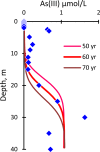Fate of Arsenic during Red River Water Infiltration into Aquifers beneath Hanoi, Vietnam
- PMID: 27958705
- PMCID: PMC5290489
- DOI: 10.1021/acs.est.6b05065
Fate of Arsenic during Red River Water Infiltration into Aquifers beneath Hanoi, Vietnam
Abstract
Recharge of Red River water into arsenic-contaminated aquifers below Hanoi was investigated. The groundwater age at 40 m depth in the aquifer underlying the river was 1.3 ± 0.8 years, determined by tritium-helium dating. This corresponds to a vertical flow rate into the aquifer of 19 m/year. Electrical conductivity and partial pressure of CO2 (PCO2) indicate that water recharged from the river is present in both the sandy Holocene and gravelly Pleistocene aquifers and is also abstracted by the pumping station. Infiltrating river water becomes anoxic in the uppermost aquifer due to the oxidation of dissolved organic carbon. Further downward, sedimentary carbon oxidation causes the reduction of As-containing Fe-oxides. Because the release of arsenic by reduction of Fe-oxides is controlled by the reaction rate, arsenic entering the solution becomes highly diluted in the high water flux and contributes little to the groundwater arsenic concentration. Instead, the As concentration in the groundwater of up to 1 μM is due to equilibrium-controlled desorption of arsenic, adsorbed to the sediment before river water started to infiltrate due to municipal pumping. Calculations indicate that it will take several decades of river water infiltration to leach arsenic from the Holocene aquifer to below the World Health Organization limit of 10 μg/L.
Conflict of interest statement
The authors declare no competing financial interest.
Figures




References
-
- Hoque M. A.; Hoque M. M.; Ahmed K. M. Declining groundwater level and aquifer dewatering in Dhaka metropolitan area, Bangladesh: causes and quantification. Hydrogeol. J. 2007, 15, 1523–1534. 10.1007/s10040-007-0226-5. - DOI
-
- Jusseret S.; Tam V. T.; Dassargues A. Groundwater flow modeling in the central zone of Hanoi, Vietnam. Hydrogeol. J. 2009, 17, 915–934. 10.1007/s10040-008-0423-x. - DOI
-
- Haque S. J.; Onodera S.; Shimizu Y. An overview of the effects of urbanization on the quantity and quality of groundwater in South Asian megacities. Limnology 2013, 14, 135–145. 10.1007/s10201-012-0392-6. - DOI
-
- Zhou Y.; Dong D.; Liu J.; Li W. Upgrading a regional groundwater level monitoring network for Beijing Plain, China. Geosci. Front. 2013, 4, 127–138. 10.1016/j.gsf.2012.03.008. - DOI
Publication types
MeSH terms
Substances
Grants and funding
LinkOut - more resources
Full Text Sources
Other Literature Sources
Medical
Research Materials

